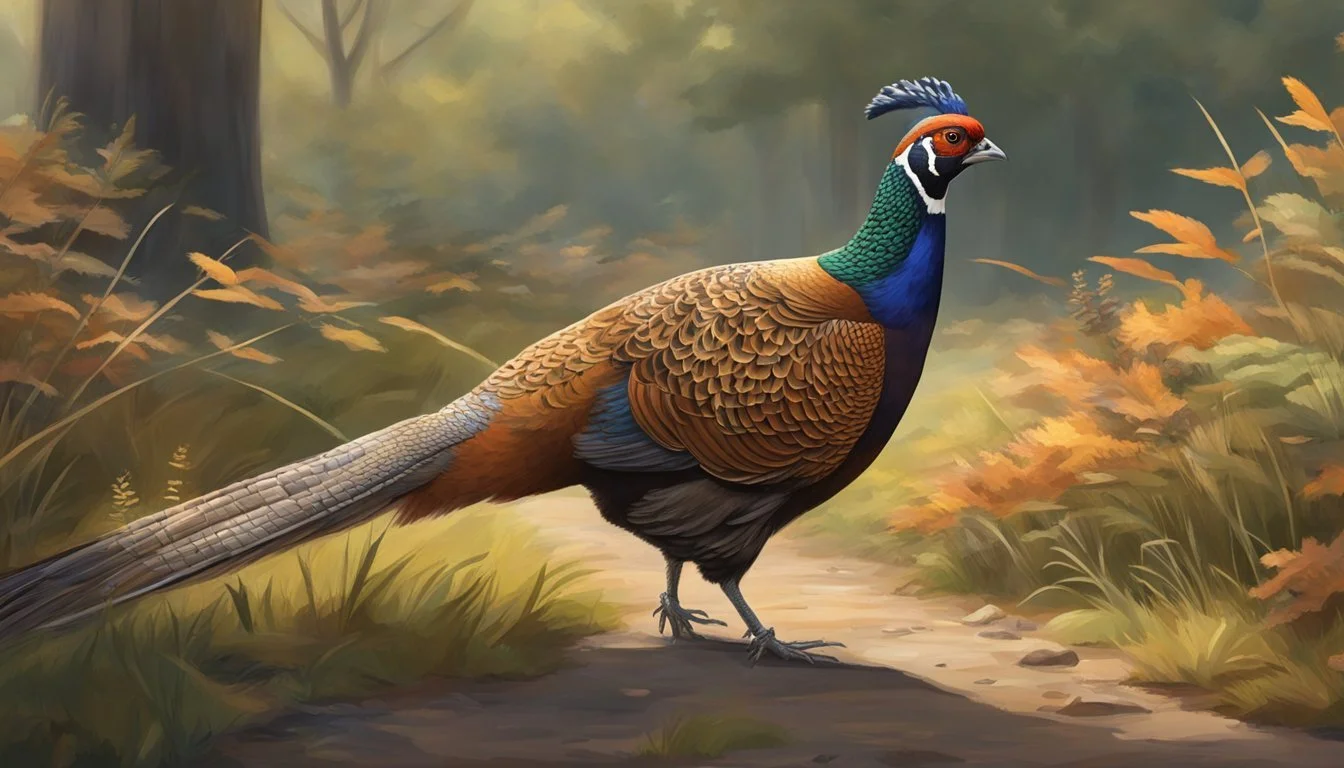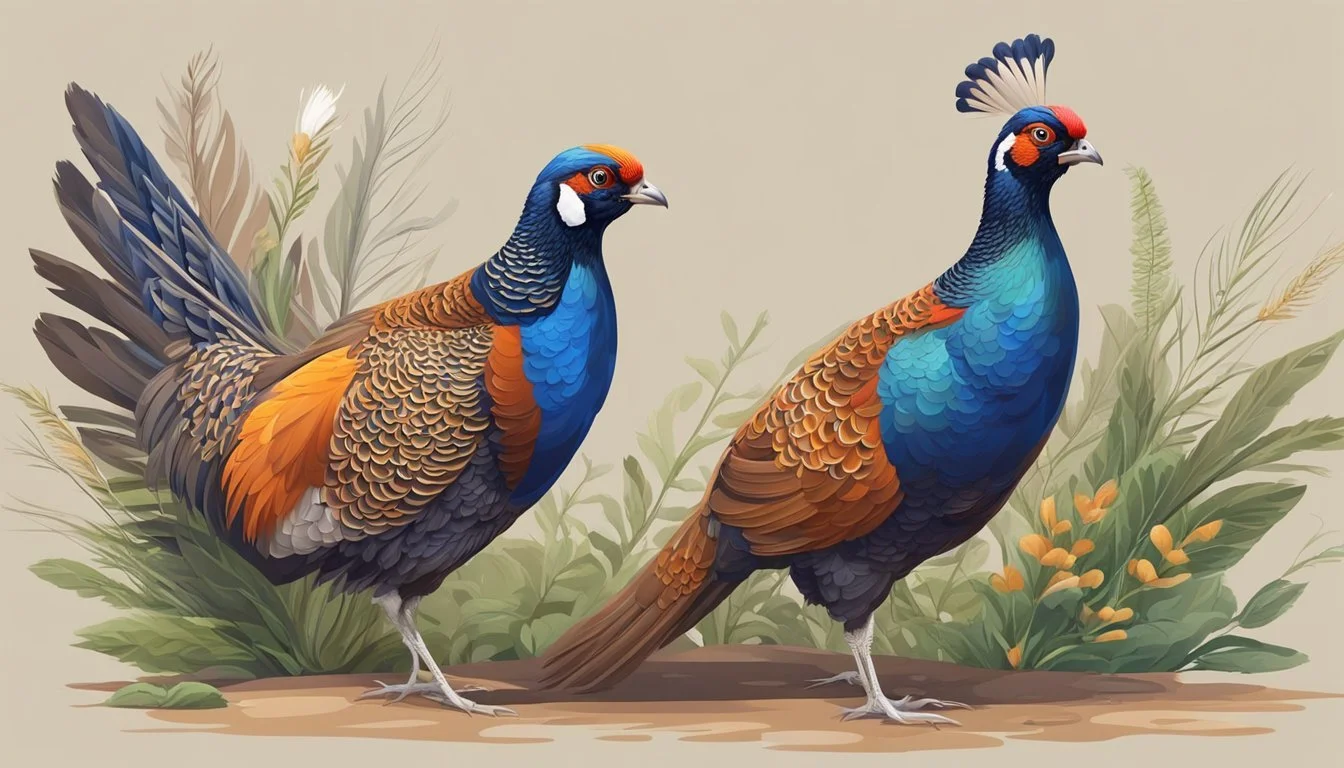Raising Pheasant
Essential Tips for Healthy, Thriving Birds
Raising pheasants presents a unique set of challenges and rewards, attracting many enthusiasts across North America. Originating from Asia, with China being a significant part of their natural range, ringneck pheasants have become popular for their ornamental value, their utility in hunting preserves, and their potential profitability when raised for meat and eggs. The pheasant's distinctive plumage and the allure of their natural behaviors make them a fascinating addition to farms and rural homesteads.
For those considering adding pheasants to their array of avian species or setting up their own pheasant farms, understanding the specific requirements of these birds is crucial for success. Pheasants require adequate space, proper nutrition, and protection from predators to thrive. These beautiful birds have a natural tendency towards aggression, especially in captivity, necessitates thoughtful management strategies to minimize stress and promote healthy flocks. Therefore, it's important to approach pheasant rearing with thorough planning and a commitment to site-specific adaptations.
Commercially, pheasant rearing can be a profitable venture if managed efficiently. Knowledge of the market demand, input costs, and careful breed selection plays vital roles in achieving a successful business model. Whether raised for sport, culinary purposes, or conservation, pheasants offer multiple avenues for farmers to explore. For hobbyists and professionals alike, raising pheasants can be a deeply rewarding experience when the endeavor is approached with informed practices and care.
Getting Started with Pheasant Raising
Embarking on the journey of raising healthy adult pheasants requires a blend of understanding their unique biology and careful planning to successfully raise these birds into healthy pheasants. From hatching candle pheasant eggs to raising healthy pheasants in your makeshift brooder house, this section navigates through the initial steps vital for establishing a successful pheasant raising operation.
Understanding Pheasant Biology
Pheasant biology plays a crucial role in their management and care. The Ring-necked pheasant (Phasianus colchicus), a well-known game bird, requires particular attention to its habitat, diet, and overall husbandry to thrive. These birds transition through different life stages from hatchling to adult, and each stage demands specific care. For instance, pheasant chicks are extremely vulnerable and have specific heat requirements, necessitating the use of a lighted 250-watt, red-end, infrared heat lamp during the initial 4-5 weeks of their lives.
The ideal conditions for these chicks include maintaining the temperature with a bulb that serves as a lighted heat source for every 100 chicks, which should be placed around 18 inches above the floor to provide the right amount of heat without having to be concerned with the intense light. As the pheasants reach adulthood, their living environment needs to be adjusted to resemble the natural habitat of wild pheasants. This approach is vital not only for their health but also for ensuring their ability to breed, particularly if they are being raised for reproductive purposes.
Initial Considerations
Before purchasing pheasant chicks or eggs, one must contemplate several factors to lay the groundwork for a prosperous endeavor in raising these birds.
Creating a safe and comfortable environment is paramount; this involves designing both the brooding area and the raising pens to accommodate the birds' needs for space, protection from weather and predators, and maintaining proper sanitation.
Selecting a trustworthy source for ring-necked pheasant eggs or chicks is also crucial. If you're working with layers, it's advisable to set eggs every week to 10 days to maintain a consistent flow and effectively manage different age groups during the breeding season.
For those raising pheasants, beginning with chicks is often more straightforward than starting with eggs, as it circumvents the complexities of handling multiple age groups. Ensuring the chicks have access to a nutritious diet, clean water, and adequate protection from the elements and predators is key to their development.
Creating a Suitable Habitat
Pheasant chicks require a carefully controlled environment to thrive, starting with a properly equipped brooder and transitioning to a well-designed outdoor pheasant pen that meets their needs for shelter and space.
Brooder Requirements
The conventional brooder house serves as the initial shelter for ring-necked pheasant chicks, ensuring they have a safe environment with adequate heat from commercial heat lamps to achieve proper conditions. The brooder space allotted should be 3/4 square foot per baby pheasant. A heat source is critical in self-contained brooders, with many keepers utilizing heat lamps to maintain a consistent temperature. The brooder temperature should start at 95 degrees Fahrenheit and decrease by 5 degrees each week until reaching 70 degrees.
Ventilation is also vital to prevent moisture buildup and to keep the air fresh in the brooder house, yet it must not create drafts to maintain the proper temperature provided by the heat lamps. Providing a steady source of fresh water and food with an appropriate waterer and feeder are essential to maintain a disease-free environment and cannibalism among the chicks. The floor of the brooder should have suitable ground cover and dry bedding, such as wood shavings, to absorb waste and provide physical comfort. Be sure to check and avoid getting wet bedding in the brooder to help keep their environment clean.
Outdoor Pen Design
Once pheasant chicks are sufficiently feathered through time, usually around 6-8 weeks of age, they should be moved to an outdoor pen or flight pen. These pens are typically made from galvanized wire or chicken wire, offering protection from predators and the elements while allowing exposure to natural weather conditions, which is important for their development. Covered pens are recommended to provide shelter, prevent escape, and offer safety from wild birds.
The pen should offer ample space for the birds at 5 square feet per bird. This is to ensure the birds have space to move and exercise, preventing aggression and injuries that can result from overcrowding. Inside the pen, include areas with dense cover such as shrubs or grasses to mimic the birds' natural habitat and promote instinctual behaviors. Proper ventilation is necessary to maintain air circulation without causing drafts. The design must also consider the prevention of diseases by incorporating easy-to-clean surfaces and equipment.
Pheasant Nutrition and Health Management
Maintaining optimal nutrition and vigilant health monitoring are crucial for the well-being and development of pheasants. Proper pheasant feeding and equipment as well as supplements, and disease prevention measures support their growth from chicks to maturity.
Feeding Time and Guidelines
Ringneck pheasants require special feed for their high-protein diet, especially during the initial growth phase. Game bird starter feed should be provided to baby pheasants with a protein grower feed content of around 30% to support the rapid development of chicks. As they grow, the protein requirement decreases, and their diet can shift to a maintenance feed with reduced protein levels.
To support their rapid development, baby pheasants should be given a game bird starter feed that contains around 30% protein grower feed content from the time they are chicks until they reach 6 weeks of age. This starter feed often includes amprolium to help prevent coccidiosis, a common parasitic disease in poultry.
As pheasants mature past the 6-week mark and enter the grower phase, which lasts until they are about 20 weeks old, they can be transitioned to a game bird grower feed that still provides an adequate amount of protein to meet their developmental needs.
Once they reach the layer phase, the feed should be designed to offer balanced nutrients that cater to pheasant hens, ensuring they have what they need for optimal egg production.
Additionally, pheasants require constant access to fresh, clean water to stay hydrated. The incorporation of grit into their diet is essential for digestion, as it aids in grinding down the food within their gizzards.
Disease and Health Monitoring
Pheasants are susceptible to various diseases, and proactive health monitoring is essential. Regular observation can detect early signs of illness, which is critical for prompt treatment and to prevent widespread infection.
Common preventatives include:
Coccidiostats in feed to control coccidiosis among young birds
Terramycin soluble powder may be used as directed by a veterinarian for specific bacterial infections
Farmers must provide clean living conditions, quality feed, and preventative care to minimize disease outbreaks for ringneck pheasants. Proper biosecurity measures, such as quarantining new or sick birds and limiting flock exposure to wild birds, further ensure the health of the pheasants.
Breeding and Lifecycle Management
Successful pheasant breeding hinges on understanding specific requirements and stages in the lifecycle of pheasants. Managing these stages with precise care results in healthy chicks and sustainable flock growth. This is why it's important to keep a keen eye and even keep a detailed journal when planning to expand into breeding
Breeding Considerations
When planning to breed pheasants, selecting the right pair of breeders is crucial. Hens should be assessed for health and egg-laying capacity, while roosters must be vigorous and show good mating behavior. Typically, a ratio of one rooster to every five to seven hens is recommended to ensure effective fertilization.
Pheasant breeders require a habitat that meets their needs for space, shelter, and nutrition. They should be given a diet rich in protein to aid in egg production. It is important to monitor the birds for signs of disease or stress, as these can significantly impact breeding success.
Egg Incubation and Hatching
Once eggs are laid, they must be collected and placed in an incubator that provides an optimal environment for hatching. Pheasant eggs typically require:
The incubator should maintain a temperature of 99.5°F (37.5°C) and a humidity level of 55-60%, which should be increased to 70-75% just before the eggs are due to hatch. The eggs typically take about 23 to 24 days to incubate, and during this period, it is essential to carefully monitor the conditions inside the incubator to ensure high hatch rates. Regular egg rotation and candling at set intervals are important practices that allow breeders to monitor the eggs' development and remove any that are not viable, thereby maintaining the health and potential of the remaining eggs.
The incubation period for pheasant eggs is about 23 to 24 days. Careful monitoring of the incubator's conditions is crucial for high hatch rates. Keep egg rotation times for candling the eggs at regular intervals allows breeders to check on the development and discard non-viable eggs.
After the hatching period, pheasant chicks should be moved to a brooding house, where the temperature is strictly controlled. This area should be secure, airtight, and free of rodents or other potential dangers. Maintaining a brooder barn's environment helps ensure the young chicks can grow without the threat of extreme temperatures or predators.
Protecting Pheasants from Predators
Raising pheasants outdoors involves several challenges, among which protecting them from predators is critical. Predators range from mammalian foes like foxes and raccoons to avian hunters such as hawks and owls. Effective measures must be implemented for the pheasants' safety.
Shelter is a primary consideration for pheasant protection. Dense, undisturbed cover provides a natural shield against predatory eyes. Grassland habitats, complemented by wetlands or brushy areas, offer excellent refuge for pheasants against both ground and aerial threats. Suitable shelter also includes constructed environments that can act as a barrier against predators.
It is recommended to use galvanized wire when designing these pens, as it is resistant to rust and provides durability.
Chicken wire is generally not advised for use in these structures because it may lack the necessary strength to withstand larger predators. The pen should include a roof made of solid material or wire mesh to protect against avian predators from above. Walls should be constructed high and with galvanized wire to deter climbing animals and to offer strong resistance against any attempts of penetration.
Additionally, to guard against burrowing animals, the mesh should be extended below the ground level, creating a barrier that prevents predators from digging their way into the pen.In addition to structural defense, behavioral issues within the flock, such as cannibalistic tendencies, can be exacerbated by stress from predator presence. Ensuring a peaceful environment lessens these internal threats.
Finally, a predator-proof barrier, combining visibility, strength, and coverage, is essential to protect pheasants efficiently. Regular inspection and maintenance of the pens ensure any potential breaches by predators are promptly addressed. By adhering to secure practices, conservationists and enthusiasts can successfully mitigate the risk of predation in pheasant populations.
Operational Aspects of Pheasant Raising
Raising pheasants is a detailed venture requiring a precise understanding of handling and transportation as well as adherence to regulations and effective marketing strategies.
Handling and Transportation
Proper handling is essential, as pheasants are particularly sensitive to rough treatment and can experience stress easily. To minimize stress and maintain their health, it is necessary to provide a temperature-controlled environment for chicks. Brooders are used to keep the temperature at an optimal 95 degrees Fahrenheit during the first week of life, with a reduction of five degrees each week thereafter.
While having adequate floor space in transport crates is critical to prevent overcrowding; providers typically allow a minimum of 0.6 square feet per chick. For mature pheasants, flight pens are required during transport to protect their feathers and allow enough space for exercise, which is crucial for their development and well-being.
Regulations and Marketing
For those interested in raising and marketing pheasants in Texas, it is imperative to understand and adhere to the relevant regulations. To operate legally, one must acquire a game farm license, which is specific to the breeding, raising, and selling of game birds. Beyond obtaining the necessary license, it's crucial to be well-versed in both local and federal laws that govern the breeding and sale of pheasants to ensure full compliance and to avoid any legal issues.
Additionally, identifying the right target markets is a key factor in the profitability of raising pheasants. Potential markets may include gourmet food restaurants, hunting preserves, and organizations or efforts aimed at restocking pheasants in the wild. Marketing strategies might also target private individuals who have interests in custom slaughter or using pheasants for homeschool educational projects.
Furthermore, enhancing the market appeal of pheasants can be achieved by offering recipes or related products, which can attract customers and add value to the pheasants being sold. By providing these additional resources, one can increase the marketing potential and profitability of their pheasant-raising venture.
Time commitment and careful planning in both the operational and regulatory/marketing aspects are paramount for success in raising pheasants.






